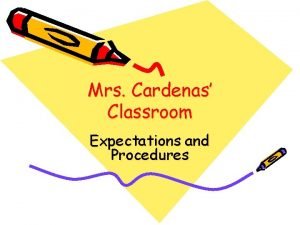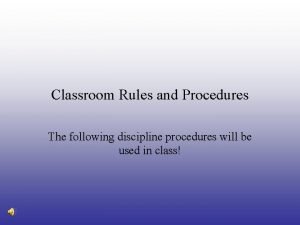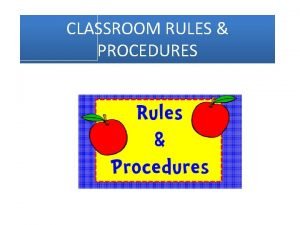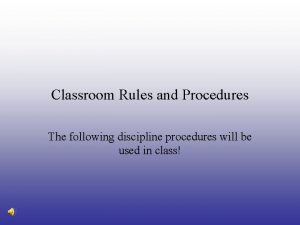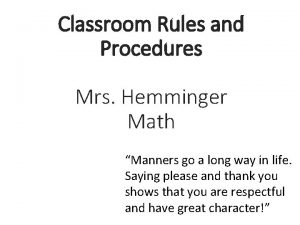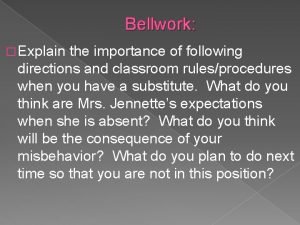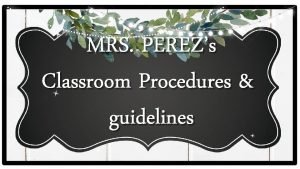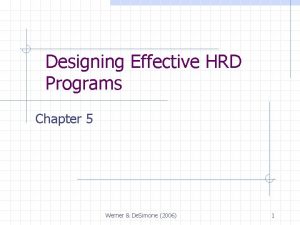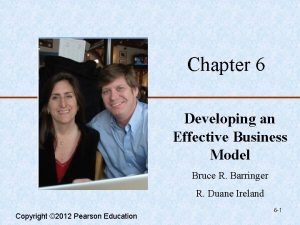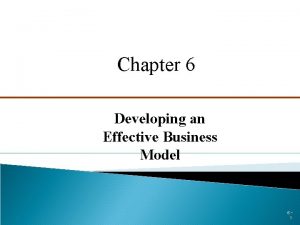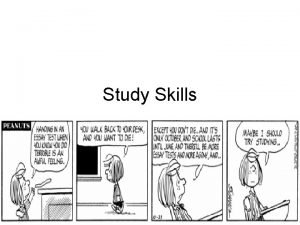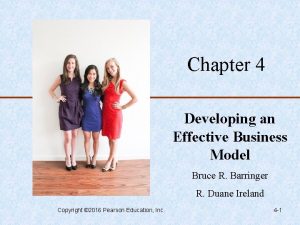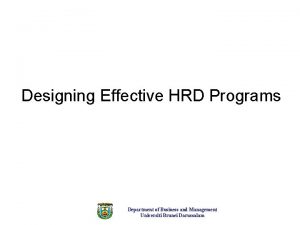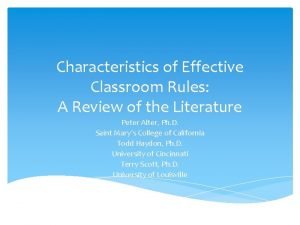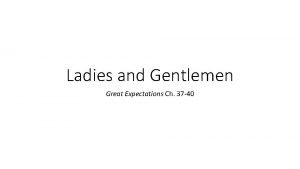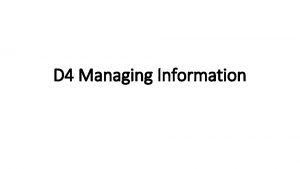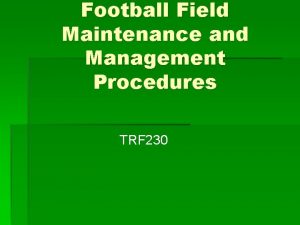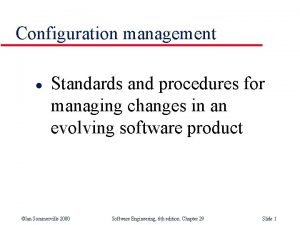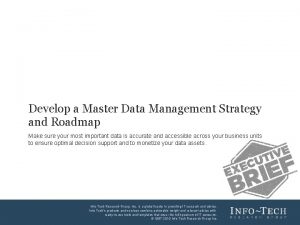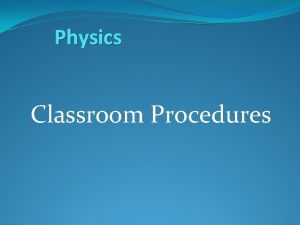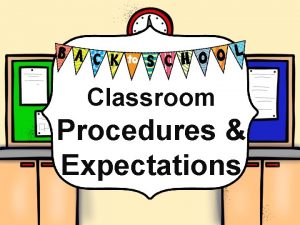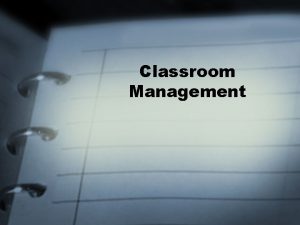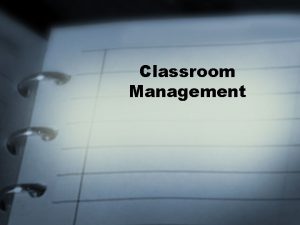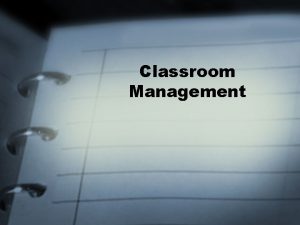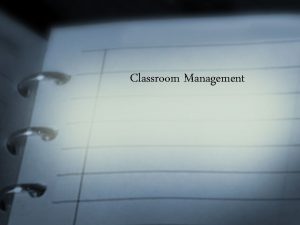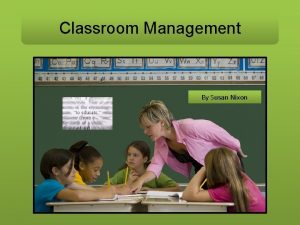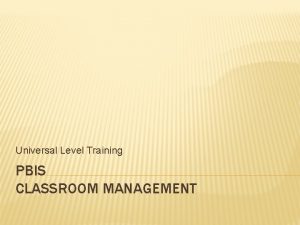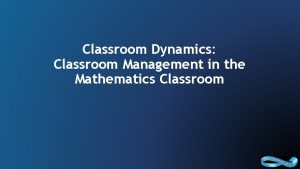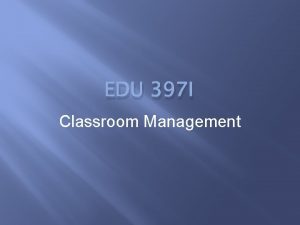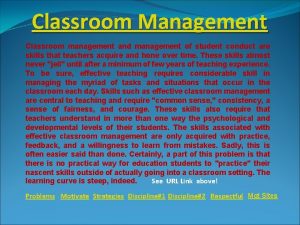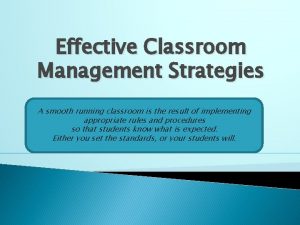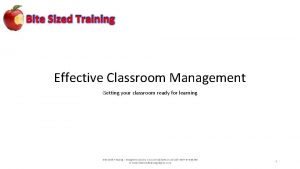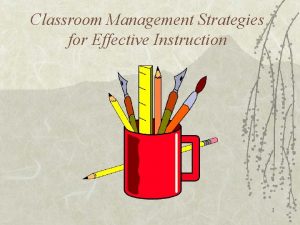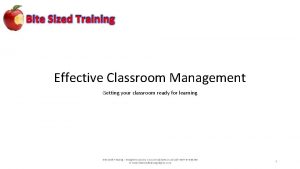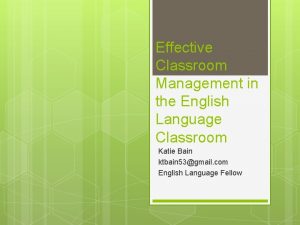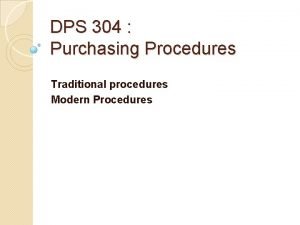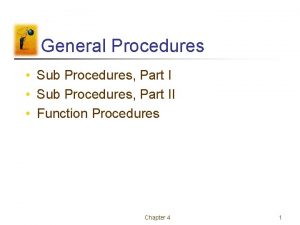WELCOME TO DEVELOPING PROCEDURES FOR EFFECTIVE CLASSROOM MANAGEMENT


























- Slides: 26

WELCOME TO DEVELOPING PROCEDURES FOR EFFECTIVE CLASSROOM MANAGEMENT When you think of the topic, What’s working? What’s not working? Using post-its, jot down answers to these 2 questions and put them on the appropriate posters. 2009 by ICE 21 Prepared by Ardella Perry-Osler 1

Poster Review n Celebrate “What’s Working” n What do the other responses tell us? n Expectations for the workshop… 2009 by ICE 21 Prepared by Ardella Perry-Osler 2

Agenda & Learning Activities Review Harry Wong’s Discipline vs. Management -Create your own 2009 by ICE 21 Prepared by Ardella Perry-Osler -Reflection -Small table discussions -Visuals, video -Planning -Whole group discussion -Sharing Out -Reframing 3

TO GET THE MOST OUT OF OUR BRIEF TIME TOGETHER: What are the norms we need to set? 2009 by ICE 21 Prepared by Ardella Perry-Osler 4

“Toto, I have a feeling we’re not in Kansas anymore. ” It always helps to know where you are! Complete the “Rate Your Classroom Disciplinary Practices” handout. (It won’t be graded!) 2009 by ICE 21 Prepared by Ardella Perry-Osler 5

Small Talk: n At your table, determine what the trends are for the answers checked: n Which behaviors did most of you mark as “Usually”? Which behaviors did most of you mark as “Sometimes”? Which behaviors did most of you mark as “Never”? n n 2009 by ICE 21 Prepared by Ardella Perry-Osler 6

Discipline vs. Procedures As you watch Harry Wong’s presentation of “Discipline and Procedures, ” use the handout to jot down ideas that are important to you. n n We will use these as “Talking Points” later. 2009 by ICE 21 Prepared by Ardella Perry-Osler 7

Whole Group Discussion Please share the talking points you recorded with the larger group. 2009 by ICE 21 Prepared by Ardella Perry-Osler 8

Sample Procedure: How would you teach this procedure and model it? 2009 by ICE 21 Procedures for Going to Art Class. 1. Close your books and leave your paper and pencils on your desk. 2. Stand up, push in your chair and place your hands on the back of the seat. 3. When your name is called, get in line quietly and face forward. 4. Follow the line leader down the hall using hallway manners. 5. The last person out will close the door for us. Prepared by Ardella Perry-Osler 9

Creating Procedures For a School Activity. n n n What’s a school activity that usually causes discipline problems? Let’s write a set of procedures together for the activity. Wong had a few points to revisit…. 2009 by ICE 21 Prepared by Ardella Perry-Osler 10

Wongisms…. Procedure = what the teacher wants done. n Routine= what the students do automatically. n 2009 by ICE 21 Prepared by Ardella Perry-Osler Ask yourself: n Where are my students? n What signal will I use? n How many steps will I need? 11

“WHAT’S YOURS? ” ØYou will be working with your mentor to create procedures for one or two specific classroom activities. ØSeveral of you will get an opportunity to model how to teach the procedure. We will review it with you to see if any steps need to be included. 2009 by ICE 21 Prepared by Ardella Perry-Osler 12

Is there anything else to consider when the procedures are in place and the discipline is still problematic? 2009 by ICE 21 Prepared by Ardella Perry-Osler 13

WHAT ABOUTINFLUENCES THE WAY INSTRUCTION STUDENT DISCIPLINE. WE TEACH? n n n Teacher is glued to the desk Unenthusiastic voice Teacher gets sidetracked by irrelevant questions Teacher is tied to the textbook; ignores questions Repeat student answers too frequently 2009 by ICE 21 Prepared by Ardella Perry-Osler 14

Continued: n n n Moving on before concepts are clear or understood. Poorly worded questions; clouded discussion. Only teacher is expected to answer questions. (“Anyone? ”) Content is not tied to prior knowledge. Focus is on teaching, not on learning. Teacher not prepared. (No plans were left!) 2009 by ICE 21 Prepared by Ardella Perry-Osler 15

WHAT ABOUT Are You Using The. LANGUAGE Language of Negotiation? AND VOICE? ÆThe Child Voice – Defensive, victimized, emotional, whining, losing attitude, strongly negative. . ÆThe Parent Voice – Authoritative, directive, judgmental, evaluative, win-lose mentality, demanding, punitive, sometimes threatening. ÆThe Adult Voice – Non-judgmental, free of negative non-verbal, factual, often in question format, attitude of win-win. Source = Ruby Payne- “a Framework for Understanding Poverty” 2009 by ICE 21 Prepared by Ardella Perry-Osler 16

BUT WHAT ABOUT THESE KIDS? I THINK WE’RE IN A POWER STRUGGLE! I need more ammo! 2009 by ICE 21 Prepared by Ardella Perry-Osler 17

WHAT MAKES THOSE KIDS ACT LIKE THAT? Every behavior has a motivator: RESPECT BELONGING POWER 2009 by ICE 21 Prepared by Ardella Perry-Osler Source: Power Struggles by Mendler 18

RE – TOOLING (INTERVENTIONS) Basic Defusing Techniques: P. E. P. – (Privacy, Eye Contact and Proximity) L. A. A. D. - (Listening, Acknowledging, Agreeing, Deferring) Use Defusing Statements 2009 by ICE 21 Prepared by Ardella Perry-Osler 19

Procedures for when rules are broken: 1. State the rule and consequence using P. E. P. 2. Ignore the last hook. 3. Use Listening and Acknowledging. 4. Use Agreeing and Deferring. 5. Tell there’s a power struggle happening. 6. Give temporary control. 7. Decide if a consequence is necessary. 2009 by ICE 21 Prepared by Ardella Perry-Osler 20

Look at this lady and think, “What can I do personally to improve student behavior in my classroom? Change your perception by Reframing. 2009 by ICE 21 Prepared by Ardella Perry-Osler 21

Reframe – What do you see when you think of music? 2009 by ICE 21 Prepared by Ardella Perry-Osler 22

Reframing may help you change your relationship with your students. Try to see them in a new “frame: ” STUBBORN DETERMINED BOSSY LEADER NOSY INQUISITIVE FUSSY DETERMINED RUDE FORTHRIGHT 2009 by ICE 21 Prepared by Ardella Perry-Osler 23

TAKE GOOD EMOTIONAL CARE OF YOURSELF 2009 by ICE 21 Prepared by Ardella Perry-Osler 24

PROCEDURES FOR OUR CLOSING: Please: n Complete the evaluation. n Put it on the table. n Pick up the CPDU form and the “I am The Best Child” handout. n Return to your seat. n Help put materials back into the table bags (if present). n Read through the handout while others complete their work. Thanks! 2009 by ICE 21 Prepared by Ardella Perry-Osler 25

REFLECTION: How I see children affects everything. 2009 by ICE 21 Prepared by Ardella Perry-Osler 26
 Elements for effective classroom management
Elements for effective classroom management Classroom procedures
Classroom procedures Classroom policies and procedures
Classroom policies and procedures Classroom procedures and expectations
Classroom procedures and expectations Procedures for entering and exiting the classroom
Procedures for entering and exiting the classroom Math class rules and procedures
Math class rules and procedures Importance of following directions in the army
Importance of following directions in the army Procedures for entering the classroom
Procedures for entering the classroom Designing effective hrd programs
Designing effective hrd programs Components of an effective business model
Components of an effective business model Core strategy business model
Core strategy business model Developing effective study skills
Developing effective study skills Barringer/ireland business model example
Barringer/ireland business model example Steps in developing effective communications
Steps in developing effective communications Ineffictive
Ineffictive Developing effective research proposals
Developing effective research proposals Effective problem solving always involves
Effective problem solving always involves Hrd design
Hrd design Cse smart class
Cse smart class Characteristics of effective classroom rules
Characteristics of effective classroom rules Welcome to google classroom
Welcome to google classroom If ladies and gentlemen was a person
If ladies and gentlemen was a person Wise men three clever are we
Wise men three clever are we Managing information between professionals
Managing information between professionals Football field maintenance and management procedures
Football field maintenance and management procedures Configuration management standards and procedures
Configuration management standards and procedures Master data management roadmap ppt
Master data management roadmap ppt

